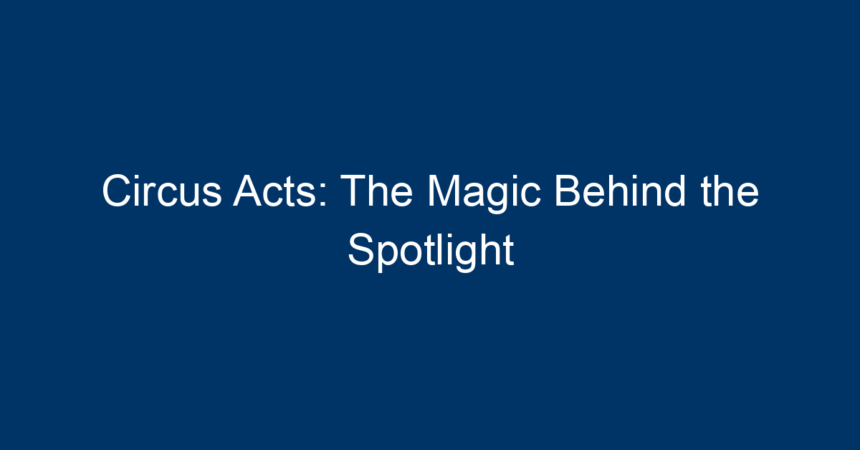The circus has long been a cornerstone of entertainment, captivating audiences with its thrilling performances and mesmerizing acts. From daring acrobats to enchanting clowns, circus acts bring together an extraordinary range of skills that blend artistry and athleticism. But what truly makes these performances magical? In this article, we will explore the behind-the-scenes elements that elevate circus acts, the different types of performances, and how they continue to evolve in today’s entertainment landscape.
The History of Circus Acts
To appreciate modern circus acts fully, we must first dive into their rich history. The roots of the circus can be traced back to ancient Rome, where chariot races and gladiatorial contests entertained the masses. However, the contemporary circus as we know it began to take shape in the late 18th century with Philip Astley, an Englishman who created the first circus ring.
Astley’s innovations laid the groundwork for various acts, from tightrope walking to horse displays. Over the years, the circus has woven a tapestry of culture, incorporating elements from different traditions and communities. This rich blend allows for diverse performances, each with its own unique flair.
The Anatomy of Circus Acts
1. Acrobatics: The Art of Flight
One of the most thrilling aspects of circus acts is acrobatics. Acrobats showcase extraordinary flexibility and strength, performing stunts like flips, human pyramids, and aerial routines. The artistry lies not only in their physical prowess but also in their ability to tell a story through movement.
Key Features:
- Trapeze Artists: These aerial performers often captivate audiences with their synchronized aerial feats, leaps, and catches.
- Contortionists: Pushing the boundaries of the human body, these artists twist and bend in ways that seem impossible, creating a visual spectacle.
2. Clowning: The Heart of Laughter
Clowns are perhaps the most recognizable figures in circus acts. They serve as the comedic relief, engaging the audience with their quirky antics, slapstick humor, and larger-than-life personas.
Types of Clowns:
- Whiteface Clowns: Dressed in all white with exaggerated facial features, they perform sophisticated acts intertwined with humor.
- Auguste Clowns: These are the more playful, often messy clowns who embody fun and chaos.
3. Animal Acts: The Bond Between Man and Beast
Animal acts are a traditional component of circus performances, showcasing the intricate bond between humans and animals. From elephants to tigers, these acts depict the grace and beauty of our animal counterparts.
Modern Take: Many contemporary circuses emphasize animal welfare, often opting for human-only acts or ensuring that animals are treated ethically in their performances.
4. Specialty Acts: Unique Talents Abound
Beyond the standard fare, specialty acts contribute to the diverse tapestry of circus performances.
Examples Include:
- Juggling: Juggling artists utilize precision, timing, and creativity, often incorporating fire, knives, or unexpected props.
- Magic Tricks: Illusionists create intrigue and suspense, captivating the audience with mind-bending tricks and the illusion of reality.
The Ecosystem of Circus Acts
Behind the glitz and glamour of the spotlight lies a complex ecosystem that ensures the seamless execution of each performance.
1. Training and Rehearsal
The journey of a circus performer often begins at a young age. Aspiring acrobats and clowns typically undergo rigorous training, sometimes in specialized schools. This continuous practice is vital, as performers need to master techniques and develop their unique styles while ensuring safety.
2. Costuming and Preparation
Costumes play a pivotal role in circus acts. They enhance the performance by adding visual flair and helping to define each character. Costume design is an essential part of the process, requiring collaboration among designers, performers, and directors to create the right look and feel.
3. Production Teams: The Unsung Heroes
While performers shine in the spotlight, behind them are dedicated production teams working tirelessly to guarantee the show goes off without a hitch. These include stagehands, lighting technicians, sound engineers, and directors who coordinate every aspect of the performance.
The Evolution of Circus Acts
As society evolves, so do circus acts. Today’s productions reflect contemporary themes and social issues, incorporating elements from theater, dance, and even acrobatics inspired by urban culture.
1. Circus Without Animals
Amid growing concerns for animal rights, many modern circuses have transitioned to animal-free shows. They rely on the incredible talents of human performers to deliver captivating narratives that engage audiences without using live animals.
2. Incorporation of Technology
With advancements in technology, circus acts have utilized new tools to amplify performances. From intricate lighting displays to flying drones, today’s circuses embrace innovation, allowing for breathtaking visual experiences.
3. Global Influences
The influence of global cultures has led to a rich diversity in performances and styles. Traditional Chinese acrobatics, Brazilian capoeira, and African dance are just a few examples where international flair enriches local performances.
The Impact of Circus Acts on Culture
Circus acts are not merely a form of entertainment; they contribute to the cultural fabric of societies.
1. Community Engagement
Many circuses engage in community outreach, offering workshops and training programs that encourage participation from individuals of all ages. These programs help foster creativity, teamwork, and physical fitness.
2. Cultural Preservation
Many circuses celebrate and preserve traditional circus acts that might otherwise be forgotten. Through their performances, they keep alive art forms and heritage that enrich cultural diversity.
Actionable Insights for Aspiring Circus Artists
-
Train Continuously: Whether you’re an acrobat or a clown, ongoing training is essential for honing your skills and staying safe.
-
Develop Your Unique Style: Each performer should aim to cultivate a personal brand and style that sets them apart from the crowd. This helps in attracting audiences and building a loyal fan base.
-
Network and Collaborate: Connect with other artists and professionals in the industry. Collaboration can lead to unique projects and performances that may capture the audience’s imagination.
-
Utilize Social Media: Use platforms like Instagram or TikTok to showcase your talents. Engaging content can help you reach a broader audience and attract potential opportunities.
- Stay Informed: Keep up with industry trends to ensure your acts remain relevant and captivating. Attend workshops or conferences to learn from established professionals.
Conclusion
Circus acts are more than just a series of performances; they are a magical fusion of artistry, athleticism, and storytelling that transcends cultural boundaries. From the heart-pounding thrill of the trapeze artist to the laughter brought by the clown, each act contributes to the enchantment that is the circus.
As the circus continues to evolve, one thing remains clear: the magic behind the spotlight lies not just in the acts themselves but in the passion, dedication, and creativity of those who bring them to life. Whether you are a performer in training or a passionate fan, embracing this evolving art form offers endless opportunities for wonder and joy.




